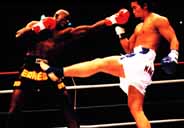|
Top Picks || Arts & Entertainment || Business & Economy || Education & Society ||
NO HOLDS BARRED: K-1 Fighting Wows Fans with the "Real Thing" September 28, 1998  Fighters kick and punch their way to victory in the K-1 ring. (K-1 Corporation) One of the latest booms on the sporting scene is K-1, a made-in-Japan potpourri of fighting sports to determine who is really the strongest of them all. The "K" comes from the first letter of the various sports that make up K-1, such as karate, kung-fu, and kick boxing, as well as the first letter of the Japanese generic term for such fighting sports--kakutogi. The "1" means that there is only one weight class, and also that the champion is truly "number one." Deciding the Strongest Man in the World Contests take place several times a year, and attract many participants from around the world, including the Netherlands, South Africa, Switzerland, the United States, and of course Japan. The sparks are sure to fly when giants as tall as 2 meters (6 feet 7 inches) and weighing 100 kilograms (220 pounds) or more enter the ring and start pounding each other with punches and kicks. And the fans love it. The tickets for 1997's grand prix tournament sold out in just one hour after going on sale. The 1998 tournament, to be held in December in Tokyo, is expected to be just as popular. Televised K-1 matches, meanwhile, earn audience shares right up with those for professional baseball and soccer. Fans Want the Real Thing Hence the idea of K-1--a sport without schools and with one set of rules--to determine the strongest man in the world. The idea has proved extremely popular. As well as pro wrestling fans, K-1 also attracts young female spectators, who previously showed little interest in fighting sports. The number of K-1 fans is increasing blow by blow. The staging of K-1 contests is good news for the fighters, too. In Europe, the sporting environment has not been such that even first-class fighters could make a go of it as professionals. But the many potential fans in Japan and elsewhere who long for "real fights" have provided the base for K-1 to be a profitable way for fighters to make a living. What is more, if a fighter wins a tournament, he can expect fame and lucrative television and commercial appearances. And, of course, he can reign as the "strongest man in the world." This year, after Europe, K-1 hit the United States--the world's biggest sports market--and thrilled a crowd of 6,000 spectators in a Las Vegas arena. Clearly, K-1's popularity looks like it will go the distance.
Also visit the K-1 Official Homepage
 Edited
by Japan Echo Inc. based on domestic Japanese news sources. Articles
presented here are offered for reference purposes and do not necessarily
represent the policy or views of the Japanese Government. Edited
by Japan Echo Inc. based on domestic Japanese news sources. Articles
presented here are offered for reference purposes and do not necessarily
represent the policy or views of the Japanese Government.
|
